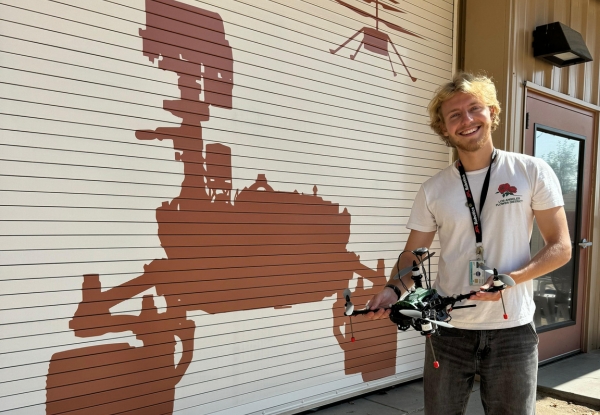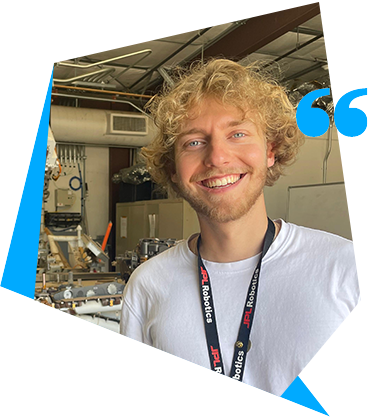< back to articles
Axel’s 6-month internship at JPL
Published on
Axel was supported by the Foundation for a 6-month internship at the Jet Propulsion Laboratory in Caltech, California, USA. During this internship, he contributed to the development of software for the Mars Science Helicopter (MSH), an innovative project which should enable further Martian exploration in the not-too-distant future.
A childhood dream that came true for Axel, and helped him confirm his goal of pursuing a career in onboard systems for space exploration.
He tells us about his stay.

Why did you choose to go to JPL?
When I arrived at NASA-JPL Caltech, I was filled with enthusiasm. I was fascinated by the idea of working alongside the most eminent researchers in robotics, the ones who had designed and launched the most sophisticated rovers on Mars. It was a dream to meet and collaborate with the teams who contributed to the design of Curiosity, Perseverance, and especially Ingenuity. For me, the latter represents the quintessence of innovation, proving the effectiveness of aerial robotics for the exploration of planets like Mars. I was convinced that this approach would embody the future of space exploration. My ambition was to become involved in an “Ingenuity 2.0” project, and to play an active part in the development of a helicopter with greater performance, power and autonomy: the Mars Science Helicopter (MSH) project.
How did your time in the laboratory go?
Axel Coulon

My time at JPL went perfectly, even beyond my expectations. I was lucky enough to join the LORNA team, a research group specializing in autonomous long-range navigation. This mission enabled me to contribute to the development of software for the navigation of a new-generation Martian helicopter. In particular, I worked on computer vision, focusing on key modules of autonomous navigation such as MBL (Mission-Based Localization), SfM (Structure from Motion), and LSD (Landing site detection). The level of research in these fields is at the cutting edge, and this project offered me the opportunity to perfect my application of these algorithms in a demanding context such as Martian exploration.
What do you take away from your stay in terms of culture?
Beyond the laboratory, I also discovered California, and that was a revelation in itself. I was deeply impressed by the grandeur of the natural spaces, the rocky desert landscapes, the vast highways, and even the iconic roads like Route 66.
This change of environment was a complete change of scenery compared to my native Lorraine in France. I loved exploring mythical places like Death Valley, Sequoia Park, San Francisco Bay and San Diego. I even spent several nights under the stars near oases in the Californian desert. These experiences have made me realize just how vast and magnificent our planet is, with so many sites to discover and protect.
Anything in particular that stood out for you?
From a cultural point of view, I was struck by the striking differences between the United States and France, particularly in terms of the relationship with money, social relations and services. In California, everything seems accessible and possible, but often at a cost. American society, especially in California, emphasizes service and convenience, and every interaction seems tinged with a commercial and marketing approach. Many restaurants, universities and cafés even have their own brand of clothing, and I’ve snapped up a few souvenirs myself! One aspect of Californian culture that particularly appealed to me was the importance attached to science. Everywhere, whether at the California Science Center, Griffith Observatory or even Pasadena Gardens, science – and astronomy in particular – is brought to the fore in a captivating way. It’s not uncommon to see whole classes of young students visiting NASA or science museums to awaken their interest in these fields. Social relations in California are also very different from those in France. Californians are incredibly polite, warm and friendly, but exchanges often remain on the surface. I found it difficult to make deep connections, although the language barrier may have helped.
How would you sum up your stay?
From an academic point of view, this experience has been extremely enriching. I had the privilege of contributing to an innovative project, the Mars Science Helicopter, which could see the light of day in a few years’ time to further Martian exploration. This project aims to answer fundamental questions about extraterrestrial life, including: did life exist elsewhere than on Earth? If so, did it take shape on Mars? Under what conditions did it develop, and how did it disappear? Designing a helicopter for space exploration poses a number of technical challenges. The constraints of mass, energy consumption, durability and reliability are particularly crucial for this type of vehicle, and as far as software and on-board systems are concerned, it is essential to optimize resources, using a minimum of sensors and actuators.
During this internship, I deepened my knowledge of computer vision algorithms and how to coordinate them to achieve autonomous navigation objectives. For MSH, the objective is to enable the helicopter to fly at altitudes of several tens of meters over distances of several kilometers, while maintaining absolute and precise localization, without deviation. All this has to be achieved autonomously, i.e. with fully automatic take-off, flight and landing, and with limited sensors: a camera, an altitude laser and an on-board inertial unit.
This internship allowed me to immerse myself in a complex mission where every detail counts. I had to understand in depth the position estimation and computer vision algorithms we were using, all of which were among the most advanced in the field. I also learned to take on significant responsibilities. In the LORNA team, hierarchy had little influence on exchanges. Meetings often took the form of scientific discussions or debates on the various solutions envisaged. Our team consisted of just seven people, and the scope of the mission far exceeded the human resources available. Every member of the team, including us trainees, had a crucial responsibility. In my case, I was in charge of implementing the landing site detection and 3D reconstruction of the terrain visible to the camera during the drone’s flight. I was responsible for this part of the embedded code and had to answer questions from other team members about my work. All in all, this internship was more like a real engineering position with responsibility than a simple internship. Although it was stressful at times, I loved the dynamic, and I’m convinced that this internship was the ideal preparation for my future career as an engineer. Every week, I had to present my progress, explain my choices, plan my schedule for the following week, and report back to the team leaders. This internship also enabled me to develop my self-confidence, improve my skills in space systems design and strengthen my knowledge of computer vision. These skills, combined with a sense of responsibility, will be invaluable throughout my career.
And on a personal level?
On a personal level, I had the opportunity to meet people from a wide variety of backgrounds, including interns and engineers from all over the world: Australia, Japan, Europe, India, South Africa… This international environment was incredibly enriching. Our discussions often revolved around our respective cultures, eating habits, worldviews… I learned an enormous amount about the customs and social relations of countries I knew little about, and these exchanges were one of the highlights of my stay. We also took many trips together, which strengthened our cohesion and made the experience all the more unforgettable.
Another highlight of my stay, if not the most important, was when we tested landing site detection and 3D reconstruction in real conditions, with an operational drone, without recourse to simulation. Seeing my work in action, seeing that the code worked well and that the results were in line with our expectations was a great satisfaction. This success has given me increased confidence and renewed motivation to continue making progress and resolving any final adjustments required. Presenting my latest results in front of twenty JPL engineers was also an exciting challenge. I had to be extremely precise in describing my work, answering questions from fastidious experts.
All in all, this trip fits in perfectly with my career path. It represents a natural continuation of my previous experiences, notably my internship at ESA, where I developed an electronic field notebook for lunar exploration, and my internship in the development of navigation policies for field, maritime and space robotics.
What’s next for you?
My goal is to continue working in the field of on-board systems for space exploration, and my experience at JPL, the world center for advanced robotics for exploration, is fully in line with this ambition. In January 2025, I’ll be joining the EAC (European Astronaut Center), where I’ll be working on the new lunar facility (LUNA) and advancing the technologies we’ll be using on the moon, particularly for the Artemis missions: i.e. rovers, field analysis tools such as microscopes, sample extraction and the electronic notebook I was able to work on at ESA a few years ago! The knowledge I’ve acquired over the last 6 months will enable me to carry out this new job, which I’m passionate about in terms of both hard and soft skills. These same skills acquired at JPL are also in line with my long-term project: to lead a European project focusing on robotics for space exploration. This stay has enabled ISAE-SUPAERO to develop its international research activity by collaborating with one of the world’s most renowned robotics centers, paving the way for future collaborations between JPL and the institute’s excellent researchers in automation, control, mechanics, robotics and computer vision.
Any final words?
I would like to sincerely thank all the Foundation’s donors, because without their support, this childhood dream would not have come true. I firmly believe that financing is often the first hurdle to overcome when it comes to realizing ambitious projects, especially for young people. I’m grateful for the collective efforts that allow us to dream big and push our limits through initiatives like this.